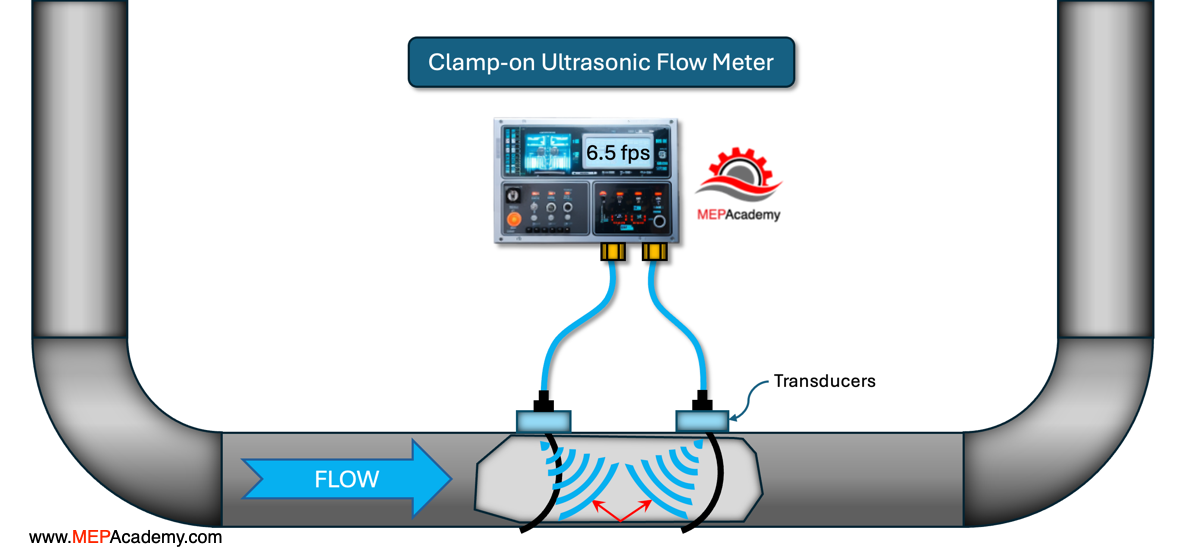In this article, we’ll look at flow meters, exploring the different types used to measure liquids, gases, and steam. Whether you’re working with water, steam, or natural gas, understanding the right flow meter for your application is critical for accuracy and efficiency. We’ll show you how to calculate the flow based on the measured data.
If you prefer to watch the video of this article, then scroll to the bottom.
Inline Magnetic Flow Meter
Magnetic flow meters measure flow based on Faraday’s law of electromagnetic induction. Two opposing magnets create a magnetic field that the fluid passes through. As the fluid passes through the magnetic field, the electrodes detect the voltage, which is proportional to the fluid flow.

This flow meter will require electrical power or an onboard battery. The information gathered from the meter can be sent to a building automation system for various sequence of operation control strategies.
There are no moving parts or obstructions in the flow path. This provides a very low to no pressure drop. This makes them a low maintenance meter while also being easy to calibrate. You will need at least 3 or more diameters of upstream straight pipe and two diameters for downstream. This is to ensure accurate readings. Check the manufacturers literature as they can vary.
Because these are inline meters and have accuracies ranging from ±0.2% to ±1% of the flow rate they are more expensive than other types especially as the pipe sizes become larger. For these reasons an inline magnetic flow meter would not be the best choice for HVAC applications unless high accuracy is required.
Insertion Turbine Flow Meter
Uses one or more turbine wheels that spin as fluid flows through the system. The rotational speed of the turbine is proportional to the flow velocity. As the turbine spins the meter keeps track of the number of complete revolutions the wheels make. The revolutions per minute is then easily converted to velocity and with a known pipe size a flow rate in GPM or liters per second can be determined.

These meters are inserted into the flow path rather than being inline, minimizing disruption to the system, while making them more affordable. These meters are more commonly specified for HVAC projects for there ease of installation and their lower price. With the use of a hot tap some of these flow meters can be installed into a pressurized and actively flowing pipe. The insertion turbine meter will require additional upstream and downstream straight pipe lengths than that required for the inline magnetic flow meter.
There will be a low pressure drop caused by the turbine wheel, and since they have moving parts, the maintenance will be greater in addition to the time between recalibrations.
Inline Vortex Flow Meter
By placing an object in the flow path that creates vortices that can be measured by the meter a frequency is created that is proportional to the flow rate. There are sensors located along the shredded vortex that measures the pressure changes. The frequency at which each vortex is shed is directly proportional to the velocity of the flowing liquid.

There is also the option to provide insertion type vortex flow meters.
The flow meter has a moderate pressure drop due to the bluff body obstructing the flow, but usually acceptable in most applications.
Clamp-on Ultrasonic Flow Meter
Ultrasonic sound waves are used to measure flow. Transducers are clamped onto the exterior of the pipe, and sound waves are sent through the pipe wall and fluid in both directions. The difference in sound wave transit time is proportional to the flow rate. The transducers act both as a transmitter and a receiver, alternating between sending and receiving sound waves.

There is no pressure drop, as there is no direct contact with the flow or intrusion into the pipe.
The flow meter is ideal for non-invasive measurement of flow in water, natural gas, and liquid applications. Common in applications where retrofitting is required, such as existing pipelines, or where contamination must be avoided.
There is a small handheld meter that can be used for smaller pipes.
Calculating Flow
To determine how much water is flowing through the system a calculation is done to derive at gallons per minute or liters per second. The flow meters determine the velocity which needs to be converted to flow based on the pipe size.
ASHRAE provides recommended velocities for various pipe sizes and whether the system is constant or variable flow. Chapter 22 of ASHRAE’s fundamentals handbook recommends that for an 8-inch pipe in a variable flow system with greater than 2,000 operating hours a velocity of 8.98 feet per second or 2.74 meters per second be used. We’ll use 9 feet per second.
To calculate flow, we’ll need to know the area of the pipe because flow requires us to know velocity and area. For an 8 inch or 200-millimeter pipe we need to determine the area. For an 8-inch pipe the area equals 0.349 ft2. The GPM equals velocity times the area times the conversion factor. The conversion factor equals 448.8312 which converts cubic feet per second to gallons per minute as follows. 1 cubic foot of water equals 7.48052 gallons.
GPM equals feet per second (Velocity) times square feet (Area) times 448.8312 which is the conversion factor.
GPM equals 9 feet per second times 0.349 square feet times 448.8312 equals 1,410 GPM
Each of these flow meters has specific strengths and limitations, so the best choice depends on factors like the fluid being measured, temperature requirements, and system pressure drop constraints.







